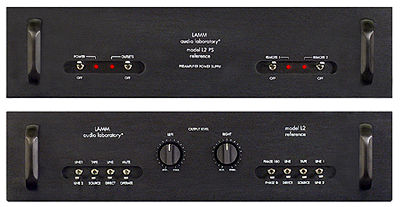| Columns Retired Columns & Blogs |
Lamm Industries L2 Reference preamplifier
The L2 Reference sits at the top of Lamm Industries' preamplifier line. According to the manual, its "unique" circuitry uses specially selected, superlinear, high-voltage MOSFET transistors that ensure class-A operation from input to output, with no overall negative feedback at any stage. All stages, including the high-current output buffers, are single-ended.

The L2 has a separate power supply that features a choke filter—an old technology that is once again popular in high-end circles—and vacuum-tube rectification and voltage regulation. According to Grand Lamm Vladimir Shushurin, special care was taken in designing the high-voltage (+350V), high-speed tube voltage regulator:
"Using this voltage regulator, in conjunction with other technical aspects, enables the reproduction of the tiniest nuances and three-dimensional subtleties in the music palette, provided they weren't lost in the recording process, of course. A somewhat unusual combination of high-voltage tube power supply and superlinear high-voltage MOSFETs allows the L2 to achieve an enormously large output voltage swing while retaining practically constant harmonic content of the signal, with an absolute dominance of the second-order harmonic."
According to Shushurin, special attention was also directed toward optimization of the L2's output impedance, allowing it to drive "without audible sonic degradation the significant capacitive loads created by many modern interconnect cables." Many? Dunno about that, but I'll leave it to Shushurin to duke it out with the cable guys. The L2 worked just fine with all the cables I had on hand; the most pleasing match was Synergistic Research Designer's Reference, especially with Active Shielding engaged. (I ran balanced to my Krell 350MC monoblocks for best sound, not to mention that these amps don't offer single-ended inputs. However, all the front-end connections were single-ended as no balanced inputs are offered on the L2.)
According to Lamm, "Each preamplifier is carefully handcrafted with matched components of the highest quality, some of which include military-grade low-noise Dale metal-film resistors; unique TKD stepped potentiometers with 41 steps; PRC wire-wound resistors; Electrocube and Roederstein film capacitors; high-frequency switching-grade Cornell Dubilier electrolytic capacitors; specially selected long-life vacuum tubes; high-quality heavy-duty gold-plated RCA connectors; and gold-plated Neutrik XLR connectors." The power supply features a custom-designed, super-low-noise toroidal power transformer, and the L2 works on all of the world's various AC line voltages (100V, 120V, 220V, 230V, 240V) "without elaborate modification."
Other features include three single-ended inputs, one tape loop (also on RCAs), balanced and single-ended outputs, an output-signal phase-inversion switch, and built-in remote power on/off facilities for Lamm power amplifiers. An electronic protection circuit mutes the outputs until the preamplifier has stabilized after turn-on, and also permits muting at the flick of a switch during normal operation. The L2 also automatically mutes when the AC line voltage drops below a predetermined level or is cut off entirely.
Description
Nothing much to it: Two black, relatively nondescript boxes with high-quality switches recessed in long, oval depressions, and a pair of knobs on the control unit. Each chassis has little rack-mount-type handles.
'Round back of the power supply chassis, right to left, sit a standard IEC mains-in, a nice big ground connector, the Power Output umbilical connector, the remote trigger connectors, and something I haven't seen on a high-end preamp in a while: two switched AC outlets, 500W max.
The preamplifier chassis' array of front-panel controls echoes the mirror-imaged, dual-mono circuitry inside. The volume potentiometers sit to either side of an imaginary vertical center line; outside to inside on each side of that line, the first three switches are the same: Line 1/Line 2, Tape/Source, Line/Direct. The fourth switch on the left selects Mute/Operate for both channels, the fourth switch on the right selects Phase (both channels, of course).
While the control section is dual-mono, the power supply is not. According to Shushurin, "There is no interaction between the channels because of the low impedance of the power supply itself."
Around back, it's all done with mirrors again: Single-ended-only input choices for each channel are Line 1, 2, and Direct, the tape loop is next to Direct; closest to the back panel's center line are the outputs, including an XLR balanced out. Above the input/output array is the 5-pin XLR socket for the umbilical to the power supply.
If, as Shushurin explains, the L2 uses "truly balanced, fully differential" circuits, I was puzzled why there are no balanced XLR inputs. "I ground the negative input on the RCAs, so I use only single-ended inputs, very simple." Over the phone, I could almost hear him shrug.
- Log in or register to post comments




































